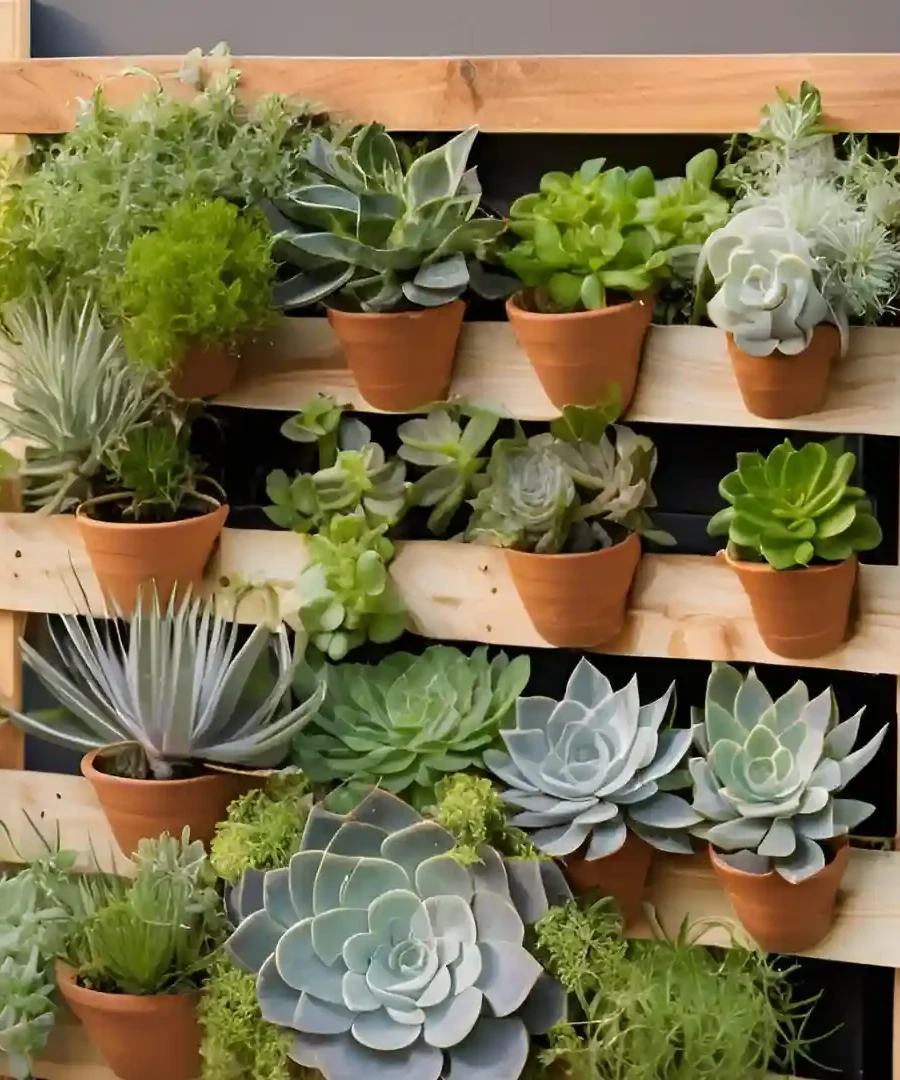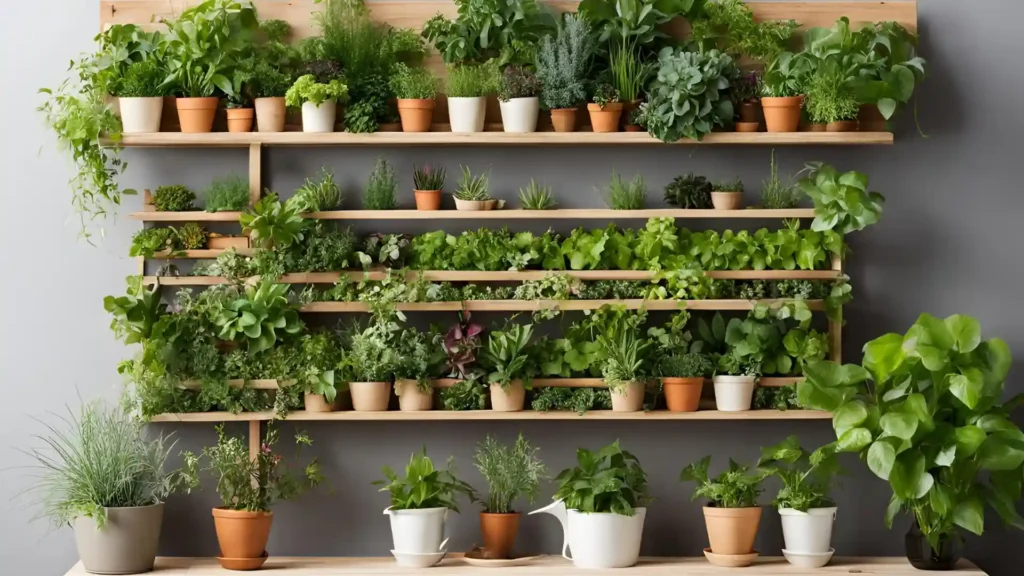Home » DIY Vertical Garden

DIY Vertical Garden
DIY Vertical Garden: A Breathing Green Wall
A DIY vertical garden is a bank of green plants standing upright, thereby giving a new paradigm to your gardening skills. Simple, yet creative, it ushers in greenery into the interiors or outdoor areas of your home or commercial establishment. Moreover, a vertical garden fits into any lifestyle. In fact, it is a picture-perfect project for a cozy apartment or a spacious backyard. Furthermore, let’s explore the benefits of vertical gardening, how to create one, and, finally, answer some common questions to get you started through this post.

Vertical Garden is it Worth It
Maximize Small Spaces
Don’t have room for a traditional garden? If so, no problem. In fact, walls, balconies, or fences can transform into verdant green spaces with the introduction of a vertical garden.
Freshen Up Your Air
What is better than plants, that too a bank of them for a healthier ambiance? As natural air purifiers, plants are known to pump out oxygen and soak in toxins.
Your Space Gets a Makeover, Naturally
A modest wall metamorphoses into a living wall with lush greens and vibrant blossoms with a vertical garden. Indeed, it is a makeover that stands upright to a standing ovation every time.
Heat Buster
A vertical garden is not just another good looker. In addition, its presence provides shade, regulates temperature, and cools your immediate surroundings.
Feel the Calm
Studies have confirmed the therapeutic effects of gardening. Even if you go for a small vertical garden, nurturing your plants can reduce stress, and bring in calm, and a sense of accomplishment.
DIY Vertical Garden: Step-by-Step Guide
Just do not worry if you are not an expert in gardening to establish a vertical garden. Follow these simple steps:
Step 1: Designate the Perfect Spot
As the first exercise, look for and designate the perfect spot for your vertical garden. Additionally, go for a vertical space. Specifically, it could be a railing in the balcony, your fence in the backyard, or a sunny kitchen wall. Moreover, ensure these spaces have enough sunlight falling on them and are sufficient for your chosen plants.
Step 2: Plants to Choose
For a vertical garden, not all kinds of plants may be suitable. Therefore, select ones that will grow healthy in your chosen space. Some good examples are listed below for your perusal.
- Flowering Greens: With Geranium, Snapdragon, Begonias, Marigolds, and Petunias, paint a color-spangled canvas.
- Flavorsome Herbs: Flavors come calling to your culinary experiments with Dill, Mint, Oregano, Rosemary, Parsley, Basil, Thyme, and Cilantro.
- Handsome Succulents: Add sculptural elegance with the robust, easy-to-care-for Purple Heart, Graptoveria, String
Step 3: Assembling and Organizing Resources
Your Requirements:
- A trellis, metal grid, or wooden pallet: for the frame or erection.
- Planters or containers: fabric pockets, recycled bottles, or small pots.
- Potting soil: suitable for your plants.
- Basic gardening tools: like a trowel and gloves.
- Hooks or brackets: to mount your garden.
- Drip irrigation: is apt, but a watering can will do the work.
Step 4: Setting up the Final Structure
- Fabricating the Frame: Tightly secure the frame to your vertical garden surface with quality screws and hooks.
- Attach Containers: Additionally, fasten the planters or pockets to the frame. Ensure that they are spaced properly and are sturdy.
- Greenery Plantation: Moreover, plant your greenery after filling the containers with soil. For visual balance, taller plants should be planted at the bottom, and cascading types at the top.
- Water Wisely: Finally, a simple drip system can help plants receive hydration methodically. Watering manually with mindfulness can also work to keep your garden flourishing.
Step 5: Vertical Garden Care
- Watering the Plants: To begin with, plants need water to grow. But be mindful. Keep checking the soil from time to time to prevent overwatering.
- Trimming and Pruning: Furthermore, a neat and handsome garden will greet you with diligent pruning and trimming.
- Be on Guard for Pests: Lastly, immediate remedial action is called for on discovery of pest infestation.
Creative Materials for Your Vertical Garden
A few fun and sustainable options to go for:
- Recycled Resources: Plastic bottles, tin cans, or old pallets should not be cast away. They could be your inspirational aids for a pocket-friendly vertical garden.
- Pockets made from Fabric: Light, breathable, and versatile for small plants.
- Wooden Crates: Great for a rustic touch.
- Metal Grids: Avant-garde, minimalist gardens could do well with them.
- Hanging Planters: Macramé or ceramic hangers usher in a creative flavor.
Recycled Materials
Pocket made from Fabric
Wooden Crates
Metal Grids
Hanging Planters
Summary
A vertical garden offers a delightful and enriching way to integrate nature into your environment. These gardens are a boon for small areas. They not only improve air quality but also give any space the ambiance of a serene, green retreat. Whether you are growing herbs for adding the flavor-punch to your recipes or just adding a living, breathing green canvas to your balcony, a vertical gardening project is a route well taken. Thus, get ready to participate in this venture and start creating your distinctive green creation today.
FAQs
Is a DIY vertical garden suitable for growing food?
Indeed! For instance, veggies like cherry tomatoes, and herbs like lettuce and spinach, grow well in vertical gardens. Furthermore, these plants thrive in the compact space provided, making them ideal for such setups.
How to water my plants in a vertical garden?
To begin with, check the soil regularly. Then, water from a can as needed. Nevertheless, for consistency, drip irrigation is a perfect method.
What about pests?
As with any garden, pests can show up. Consequently, it’s essential to be prepared. In addition, to address this, use natural solutions like neem oil or, alternatively, consider companion planting to keep them away.
How do I increase the longevity of my vertical garden?
Use quality materials, ensure good drainage, and, as a result, replace plants as needed to keep your garden vibrant.
Is an indoor DIY vertical garden possible?
In fact! Hardy plants that need next to nothing maintenance like Peace Lilies, Pothos, or Snake Plants are apt for indoors, but sunlight is a necessity here too.
Trending Post
Large Indoor Plants, Guest Bedroom Ideas, Leather Sectional, Minimalist Home Decor Ideas Hydroponics Farming, Minimalist Home Decor Ideas, Outdoor Plant Stand, Aquaponics Farming, Alternative Home Decor Ideas – Think Laterally, Summer Plants, The Benefits of Closed-Loop Gardening, The Joy of Do-It-Yourself Gardening, Sustainable Materials, Garden Hoe, Gardening as Therapy, Permaculture, Muhly Grass Care, Wheelbarrow, DIY Garden Ideas, DIY Greenhouse, Cheap DIY Garden Path Ideas, DIY Garden Fence, Snowball Bush, Sustainable Design, Sustainability and Home Decor, Small Kitchen Table Sets For 4, Outdoor Sectional Couch, How To Care For a Peace Lily Indoors, Plant Stand Indoor Walmart, Plant Stand Indoor With Grow Lights, Plant Stand Indoor Tall, Plant Stand Indoor Amazon, Kitchen Decor, Plant Stand Indoor, Snake Plant Benefits, Kitchen Decor Ideas



Pingback: Dicot